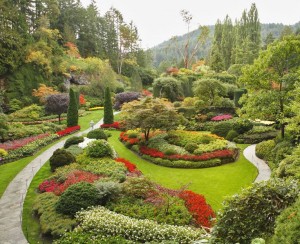 Whether you are just digging the spade into your yard for the first time or you are transplanting some perennials around the yard, you are probably thinking about garden design. What plants will you use? How many of each will you use? How many beds will you develop? What shapes will they be in? The choices can seem endless and overwhelming if you don’t have a theme or a plan to guide you.
Whether you are just digging the spade into your yard for the first time or you are transplanting some perennials around the yard, you are probably thinking about garden design. What plants will you use? How many of each will you use? How many beds will you develop? What shapes will they be in? The choices can seem endless and overwhelming if you don’t have a theme or a plan to guide you.
With some overall concepts to use in planning and by adding nameplates in your garden you can better organize your personal ideal garden strategy. Learn 2 Grow gardening experts suggest following these basic themes when planning or reorganizing a garden:
- Repetition/Consistency
- Rhythm/Transitions
- Simplicity/Proportion
- Unity
Even if you have a huge area in which to garden, it doesn’t mean that you have to put a different plant in every corner. Too many different varieties can be difficult for the eye to take in and won’t create a very relaxing atmosphere. Clumps of the same plants can still add dramatic effect, but keep a uniformity that is soothing to the eye. If you’re working on creating a new flowerbed, it might be as simple as thinning out some of your existing perennials and spreading them about the yard.
Spreading the same plants about also creates a rhythm and consistency in the yard. It ties the gardens together in unity. Rhythm can also be created by making transitions along the garden pathways. Plants or some simple sculptures, rocks or pieces of drift wood can either blend in throughout the plants in the yard or stand as structures that alert the garden stroller to a new type of garden or to the entrance or exit to the garden.
When using structural objects in your gardens, try to keep them mostly uniform. Too many fountains or woodland animals or other objects can make the garden cluttered or make it look too unorganized. Let the plants be the focal points and only use the structures if they complement the plants.
Nameplates for gardens can also add repetition, rhythm and simplicity to the garden. They cover and unify the overall garden with their style and function. Nameplates for gardens can merely identify plants or they can label garden “rooms” and serve as transitions throughout the garden.
At Kincaid Plant Markers we suggest that when you plan your garden you also consider how nameplates for gardens can help you create unity, rhythm, repetition and simple style in your landscaping. Beautiful blooms and hearty perennials deserve durable stainless steel posts to highlight their resilience and longevity. Planning a garden doesn’t just involve the plants that are going in the ground, it incorporates structural function and design that help you create cohesion to your landscaping and help tell your garden’s story.

Planning Your Garden and Plant Markers for Perennials | Kincaid Plant Markers
[…] sit in your yard? What do you love to see from that vantage point? What MORE would you like to see? Planning a garden means imagining it from the angles where you and others will see it most. Will you most likely see […]
Create Nameplates for Plants in Your Diversified Garden | Kincaid Plant Markers
[…] and lift your plants off the garden floor. With all the multiplying varieties, it helps to create nameplates for plants in your […]